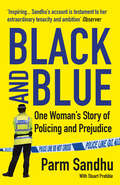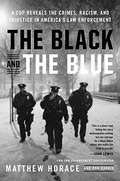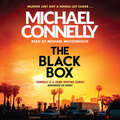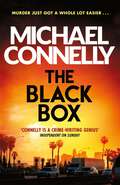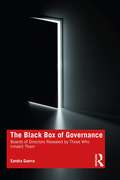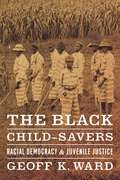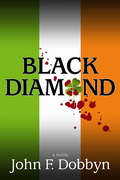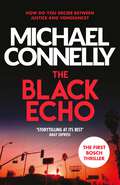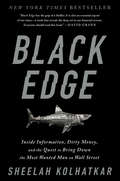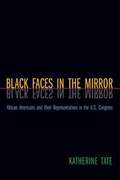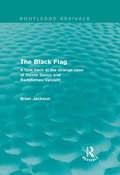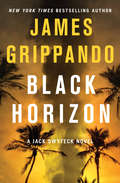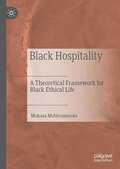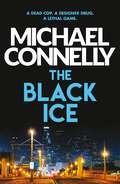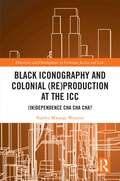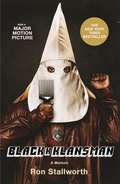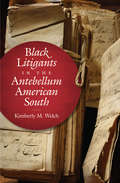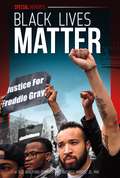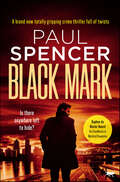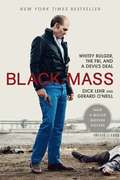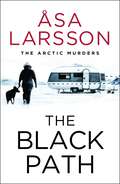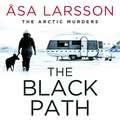- Table View
- List View
Black and Blue: One Woman's Story of Policing and Prejudice
by Parm SandhuAt the point of her retirement from the Metropolitan Police Service in 2019, Parm Sandhu was the most senior Asian woman in London's police force. She was also the only non-white female to have been promoted through the ranks from constable to chief superintendent in the Met's entire history.In this enthralling memoir, Parm chronicles her journey from life on the outskirts of Birmingham as the fourth child of immigrants from the Punjab to the upper echelons of the Met. Forced into an abusive arranged marriage aged just 16, Parm made the decision to escape to London with her newborn son and later joined the police as a constable.During her thirty-year career, Parm worked in everything from crime prevention to counter-terrorism, and she also served in the Met's police corruption unit. She played a senior organizing role in the London Olympics and was the superintendent on duty when Lee Rigby was beheaded in the street in Greenwich.However, Parm's time on the force was marked throughout with incidents of racial and gender discrimination, and, after deciding to make a stand, she found herself facing a spurious charge of gross misconduct. Black and Blue tells her shocking story and of her quest for justice in her police work and for herself. It is a story that cannot fail to inspire anyone who has experienced prejudice or abuse of any kind.
The Black and the Blue: A Cop Reveals the Crimes, Racism, and Injustice in America's Law Enforcement
by Matthew Horace Ron HarrisCNN contributor offers a searing indictment of America's law enforcement."This is a must-read.... Telling this story demonstrates nothing but raw courage for a black police officer who wants the truth to prevail." --John Lewis"[T]his [is a] hard-hitting, convincing indictment of the biases in today's law enforcement.... A must-read for anyone interested in understanding and solving these problems." --Booklist (starred review)Matthew Horace was an officer at the federal, state, and local level for 28 years working in every state in the country. Yet it was after seven years of service when Horace found himself face-down on the ground with a gun pointed at his head by a white fellow officer, that he fully understood the racism seething within America's police departments. Using gut-wrenching reportage, on-the-ground research, and personal accounts garnered by interviews with police and government officials around the country, Horace presents an insider's examination of police tactics, which he concludes is an "archaic system" built on "toxic brotherhood." Horace dissects some of the nation's most highly publicized police shootings and communities highlighted in the Black Lives Matter movement and beyond to explain how these systems and tactics have had detrimental outcomes to the people they serve. Horace provides fresh analysis on communities experiencing the high killing and imprisonment rates due to racist policing such as Ferguson, New Orleans, Baltimore, and Chicago from a law enforcement point of view and uncovers what has sown the seeds of violence.Timely and provocative, The Black and The Blue sheds light on what truly goes on behind the blue line.
The Black Box (Harry Bosch Series #16)
by Michael ConnellyMay 1992, and after four LAPD officers were acquitted after the savage beating of Rodney King, Los Angeles is ablaze. As looting and burning take over the city, law and order are swept away in a tidal wave of violence. But under threat of their lives, homicide detectives like Harry Bosch are still stubbornly trying to do their job. With no effective police presence on the streets, murder just got a whole lot easier - and investigating them got a whole lot harder. When Harry finds the body of a female journalist in an alley he is forced to hand over the case to the Riot Crimes Task Force, knowing that it will never be solved.Twenty years later, new evidence confirms her death was not a case of random violence but something much more personal. This time Harry is determined that the killer isn't going to escape - even if it means stepping back into the darkest days of the city he loves...Read by Michael McConnohie(p) 2012 Hachette Audio
The Black Box (Harry Bosch Series #16)
by Michael ConnellyMay 1992, and after four LAPD officers are acquitted following the savage beating of Rodney King, Los Angeles is ablaze. As looting and burning take over the city, law and order are swept away in a tidal wave of violence. But under threat of their lives, homicide detectives like Harry Bosch are still stubbornly trying to do their job. With no effective police presence on the streets, murder just got a whole lot easier - and investigating them a whole lot harder. When Harry finds the body of a female journalist in an alley, he is forced to hand over the case to the Riot Crimes Task Force, knowing that it will never be solved.Twenty years later, new evidence confirms her death was not a case of random violence but something much more personal. This time Harry is determined that the killer isn't going to escape - even if it means stepping back into the darkest days of the city he loves . . .
The Black Box of Governance: Boards of Directors Revealed by Those Who Inhabit Them
by Sandra GuerraIn the world of corporate governance, the board of directors is often viewed as the "black box" of companies: only the board members who are seated at the meeting table understand how this "decision-making machine" works. In this book, a board member with over 25 years’ experience pulls off the lid and shows both how boards have worked and how they could work. This book is grounded in extensive research in three different surveys: one with more than 100 Brazilian directors, another with 340 board members from 40 countries, and a final one with 103 Brazilian directors serving on 238 boards. It also includes interviews with Ira Millstein, Sir Adrian Cadbury, Robert Monks and Mervyn King. The inner-workings of the board of directors are revealed: • What keeps directors awake at night • Obstacles to efficient decision-making • Behavioral dynamics, both within the board and in relation to the management • Pitfalls that arise from individual and group biases Based on these insights and the author’s own consulting and board experience, the book presents a guide to behavioral tools enabling directors and executives to confidently navigate the boardroom, improving interactivity and the efficiency of the decision-making process. Intended for directors and executives who are directly involved in the board's activities, as well as for leaders responsible for strategy implementation, this book provides a behavioral compass for all those interacting with the "black box."
The Black Child-Savers: Racial Democracy and Juvenile Justice
by Geoff K. WardDuring the Progressive Era, a rehabilitative agenda took hold of American juvenile justice, materializing as a citizen-and-state-building project and mirroring the unequal racial politics of American democracy itself. Alongside this liberal "manufactory of citizens," a parallel structure was enacted: a Jim Crow juvenile justice system that endured across the nation for most of the twentieth century. In The Black Child Savers, the first study of the rise and fall of Jim Crow juvenile justice, Geoff Ward examines the origins and organization of this separate and unequal juvenile justice system. Ward explores how generations of "black child-savers" mobilized to challenge the threat to black youth and community interests and how this struggle grew aligned with a wider civil rights movement, eventually forcing the formal integration of American juvenile justice. Ward's book reveals nearly a century of struggle to build a more democratic model of juvenile justice--an effort that succeeded in part, but ultimately failed to deliver black youth and community to liberal rehabilitative ideals. At once an inspiring story about the shifting boundaries of race, citizenship, and democracy in America and a crucial look at the nature of racial inequality, The Black Child Savers is a stirring account of the stakes and meaning of social justice.
Black Diamond: A Novel (A Knight and Devlin Thriller #3)
by John F. DobbynIn the crosshairs of two warring mobsMichael Knight and Lex Devlin agree to defend a jockey accused of murdering a fellow jockey during a race at Boston's Suffolk Downs. Michael's expertise in the machinations of the horse racing game is expected to serve them well. But a personal attachment to the murdered jockey thrusts Michael and Lex into the midst of conflict between Boston's Irish mafia and remnants of the terrorist branch of the Irish Republican Army. Now they are in the crosshairs of both, and the brutality of these combatants knows no bounds. As Michael and Lex uncover layer after layer of deceptions involved in the seamier side of horse racing, they become more dangerous to the gangs. In action that shuttles between Ireland and Boston, the lives of the lawyers as well as those close to them are in the gravest danger and the criminals show no mercy in their quest to put an end to this threat. As their investigation hurtles forward, it could end a wonderful law partnership due to the absence of living partners.
The Black Echo (Harry Bosch Series #1)
by Michael ConnellyGo back to where it all began for LAPD detective Harry Bosch, star of Amazon Prime's Bosch, in his first case The Black Echo - a gripping, action-packed thriller.LAPD detective Harry Bosch is a loner and a nighthawk. One Sunday he gets a call-out on his pager. A body has been found in a drainage tunnel off Mulholland Drive, Hollywood. At first sight, it looks like a routine drugs overdose case, but the one new puncture wound amid the scars of old tracks leaves Bosch unconvinced.To make matters worse, Harry Bosch recognises the victim. Billy Meadows was a fellow 'tunnel rat' in Vietnam, running against the VC and the fear they all used to call the Black Echo. Bosch believes he let down Billy Meadows once before, so now he is determined to bring the killer to justice.
Black Edge: Inside Information, Dirty Money, and the Quest to Bring Down the Most Wanted Man on Wall Street
by Sheelah KolhatkarThe story of the billionaire trader Steven A. Cohen, the rise and fall of his hedge fund, SAC Capital, and the largest insider trading investigation in history—for readers of The Big Short, Den of Thieves, and Dark Money. The rise over the last two decades of a powerful new class of billionaire financiers marks a singular shift in the American economic and political landscape. Their vast reserves of concentrated wealth have allowed a small group of big winners to write their own rules of capitalism and public policy. How did we get here? Through meticulous reporting and powerful storytelling, New Yorker staff writer Sheelah Kolhatkar shows how Steve Cohen became one of the richest and most influential figures in finance—and what happened when the Justice Department put him in its crosshairs. Cohen and his fellow pioneers of the hedge fund industry didn’t lay railroads, build factories, or invent new technologies. Rather, they made their billions through speculation, by placing bets in the market that turned out to be right more often than wrong—and for this they have gained not only extreme personal wealth but formidable influence throughout society. Hedge funds now manage nearly $3 trillion in assets, and competition between them is so fierce that traders will do whatever they can to get an edge. Cohen was one of the industry’s greatest success stories. He mastered poker in high school, went off to Wharton, and in 1992 launched SAC Capital, which he built into a $15 billion empire, almost entirely on the basis of his wizardlike stock trading. He cultivated an air of mystery, reclusiveness, and extreme excess, building a 35,000 square foot mansion in Greenwich, Connecticut, and amassing one of the largest private art collections in the world. On Wall Street, Cohen was revered as a genius. That image was shattered when SAC became the target of a sprawling, seven-year government investigation. Labeled by prosecutors as a “magnet for market cheaters” whose culture encouraged the relentless hunt for “edge”—and even “black edge,” or inside information—SAC was ultimately indicted in connection with a vast insider trading scheme, even as Cohen himself was never charged. Black Edge offers a revelatory look at the gray zone in which so much of Wall Street functions, and a window into the transformation of the U.S. economy. It’s a riveting, true-life legal thriller that takes readers inside the government’s pursuit of Cohen and his employees, and raises urgent questions about the power and wealth of those who sit at the pinnacle of modern Wall Street. Advance praise for Black Edge“Well-written, with pointed characterizations of the ambitious players and their motives, this book is highly recommended for readers interested in finance, crime, and politics.”—Library Journal (starred review) “A tour de force of groundbreaking reporting and brilliant storytelling, a revealing inside account of how the Feds track a high-profile target—and, just as important, an unsettling portrayal of how Wall Street works today.”—Jeffrey Toobin, New York Times bestselling author of American Heiress “Black Edge is not just a work of major importance, it is also addictively readable—and horrifyingly compelling.”—Jane Mayer, New York Times bestselling author of Dark Money “Fast-paced and filled with twists, Black Edge has the grip of a thriller.”—David Grann, New York Times bestselling author of The Lost City of Z
Black Faces in the Mirror: African Americans and Their Representatives in the U. S. Congress
by Katherine TateHere, Katherine Tate examines the significance of race in the U. S. system of representative democracy for African Americans. Presenting important new findings, she offers the first empirical study to take up the question of representation from both sides of the constituent-representative relationship. The first half of the book examines whether black members of the U. S. House legislate and represent their constituents differently than white members do. Representation is broadly conceptualized to include not only legislators' roll call voting behavior and bill sponsorship, but also the symbolic acts in which they engage. The second half looks at the issue of representation from the perspective of ordinary African Americans based on a landmark national survey. Tate's findings are mixed. But, in the main, legislators' race does shape how they represent their constituents and how constituents evaluate them. African Americans view black representatives more positively than they do white representatives, even those who belong to their own political party. Black legislators, however, are just as likely as white representatives to sponsor and gain passage of bills in the House. Tate also concludes that black House members are more liberal as a group than are their black constituents, but that there is considerable divergence in the quality and type of representation they provide. The findings reported here will generate controversy in the fields of politics, law, and race, particularly as debate commences over renewing the Voting Rights Act, which is set to expire in 2007.
The Black Flag: A look back at the strange case of Nicola Sacco and Bartolomeo Vanzetti (Routledge Revivals)
by Brian JacksonFirst published in 1981, this book reassesses the case of Sacco and Vanzetti, two Italian immigrant anarchists living in Boston in 1920. The pair were accused of a payroll robbery and the murder of two guards for which they were arrested and, after a long trial based on inadequate and prejudiced evidence, executed in 1927. In 1977, on the fiftieth anniversary of their deaths, the Commonwealth of Massachusettes issued a proclamation which acknowledged a miscarriage of justice. The Black Flag provides an account of the controversial trial and a re-evaluation of the celebrated case of the Commonwealth’s decision. Brian Jackson puts the trial in the social context of the period and exposes the nature of anarchism by looking at the lives of two of its exponents, resulting in a moving exploration of a series of events that continue to trouble the conscience of America.
Black Horizon (Jack Swyteck #11)
by James Grippando<P>Miami attorney Jack Swyteck finds himself in the middle of an international legal battle over a Cuban oil spill that sets him on a deadly mission. <P>Three summers after the Deepwater Horizon environmental catastrophe, oil is spewing into the ocean again, this time from a drilling explosion in Cuban waters just fifty miles from the Florida Keys. The slick is headed straight for the United States, but the Cubans refuse American offers to assist with the cleanup, and threaten to fire on "hostile" U.S. vessels entering their waters. Backstopping the Cubans is the powerful consortium that owned and operated the rig, and is tied to the Chinese, Russian, and Venezuelan governments, who stonewall all inquiries and relief efforts. <P>Jack and his new wife, Andie Henning, an undercover agent for the FBI, are honeymooning in the Keys when Andie is called away on an assignment shrouded in secrecy. Jack, too, is soon back at work, representing an American woman whose Cuban husband was killed in the rig explosion. Though the spill occurred in foreign waters, Jack draws on all his legal know-how to file a wrongful death suit in a U.S. court and hopefully bring the young widow a semblance of closure. <P>Jack's pursuit of the unimaginably complicated international case plunges him into a dangerous world filled with treacherous twists that lead him--and Andie--to the same shocking realization . . . that the looming environmental disaster may have been no "accident" at all.
Black Hospitality: A Theoretical Framework for Black Ethical Life
by Mukasa MubirumusokeThis book addresses the paucity of robust reflections on ethics as a distinct field of experience in recent Black Studies scholarship. Following the intervention of the Afro-Pessimist school of thought—spearheaded by the likes of Frank Wilderson III and Jared Sexton—there has been much needed attention brought to the totalizing nature of Black political degradation and vulnerability in America. However, an in depth reflection on the ethical implications of this political positionality is lacking and in places even implied to not be possible. Black Hospitality conceptualizes what the author argues is the aporetic experience of Black ethical life as both excessively vulnerable within and yet also ultimately hostile to an anti-black political ontology. Engaging the work of scholars such as Fred Moten, Saidiya Hartman, Nahum Chandler, Jacques Derrida, Theodor Adorno, and Toni Morrison, along with the concepts of fugitivity, Black sociality, im-possibility, and paraontology, Black Hospitality insists that Black ethical life provides a necessary broadening of the contours of Black experience.
The Black Ice (Harry Bosch Series #2)
by Michael ConnellyWhen a body is found in a hotel room, reporters are soon all over the case: it appears to be a missing LAPD narcotics detective, apparently gone to the bad. The rumours were that he had been selling a new drug called Black Ice that had been infiltrating Los Angeles from the Mexican cartel. The LAPD are quick to declare the death a suicide, but Harry Bosch is not so sure. There are odd mysteries and unexplained details from the crime scene which just don't add up. Fighting an attraction to the detective's widow, Bosch starts his own maverick investigation, which soon leads him over the borders and into a dangerous world of shifting identities, police politics and deadly corruption . . .
Black Iconography and Colonial (re)production at the ICC: (In)dependence Cha Cha Cha?
by Stanley Mwangi WanjiruThis book explores the reproduction of colonialism at the International Criminal Court (ICC), and examines International criminal law (ICL) vs the Black body through an immersive format of Art, Music, Poetry, and Architecture and post-colonial/critical race theory lens. Taking a multi-disciplinary approach, the book interrogates the operationalization of the Rome statute to detail a Eurocentric hegemony at the core of ICL. It explores how colonialism and slavery have come to shape ICL, exposing the perpetuation of the colonial and warns that it heralds ominous contemporary and future implications for Africa. As currently envisaged and acted out at the ICC, this law is founded on deceptive and colonial ideas of ‘what is wrong’ in/with the world. The book finds that the contemporary ICL regime is founded on white supremacy that corrupts the law’s interaction with the African. The African is but a unit utilised by the global elite to exploit and extract. From time to time, these alliances disintegrate with ICL becoming a retaliatory tool of choice. What is at stake, is power, not justice. This power is hierarchical with Eurocentrism at the top throughout modern history. Colonialism is seen not to have ended but to have regerminated through the foundation of the ‘independent’ African state. The ICC reproduces the colonial by use of European law, and ultimately the over representation of the black accused. To conclude, the book provides a liberated African forum that can address conflicts in the content, with a call for the end of the ICC’s involvement in Africa. The demand is made for an African Court that utilises non-colonising African norms which are uniquely suited to address local conflicts. Multidisciplinary in nature, this book will be of great interest to students and scholars of International Criminal Law, Criminal Justice, Human Rights Law, African Studies, Global Social Justice, Sociology, Anthropology, Postcolonial Studies, and Philosophy.
Black Klansman: Race, Hate, and the Undercover Investigation of a Lifetime
by Ron StallworthThe extraordinary true story and basis for the major motion picture BlacKkKlansman, written and directed by Spike Lee, produced by Jordan Peele, and starring John David Washington and Adam Driver. <P><P>When detective Ron Stallworth, the first black detective in the history of the Colorado Springs Police Department, comes across a classified ad in the local paper asking for all those interested in joining the Ku Klux Klan to contact a P.O. box, Detective Stallworth does his job and responds with interest, using his real name while posing as a white man. <P><P>He figures he’ll receive a few brochures in the mail, maybe even a magazine, and learn more about a growing terrorist threat in his community. A few weeks later the office phone rings, and the caller asks Ron a question he thought he’d never have to answer, “Would you like to join our cause?” <P><P>This is 1978, and the KKK is on the rise in the United States. Its Grand Wizard, David Duke, has made a name for himself, appearing on talk shows, and major magazine interviews preaching a “kinder” Klan that wants nothing more than to preserve a heritage, and to restore a nation to its former glory. <P><P>Ron answers the caller’s question that night with a yes, launching what is surely one of the most audacious, and incredible undercover investigations in history. Ron recruits his partner Chuck to play the "white" Ron Stallworth, while Stallworth himself conducts all subsequent phone conversations. <P><P>During the months-long investigation, Stallworth sabotages cross burnings, exposes white supremacists in the military, and even befriends David Duke himself. Black Klansman is an amazing true story that reads like a crime thriller, and a searing portrait of a divided America and the extraordinary heroes who dare to fight back. <P><b>A New York Times Bestseller</b>
Black Litigants in the Antebellum American South (The John Hope Franklin Series in African American History and Culture)
by Kimberly M. WelchIn the antebellum Natchez district, in the heart of slave country, black people sued white people in all-white courtrooms. They sued to enforce the terms of their contracts, recover unpaid debts, recuperate back wages, and claim damages for assault. They sued in conflicts over property and personal status. And they often won. Based on new research conducted in courthouse basements and storage sheds in rural Mississippi and Louisiana, Kimberly Welch draws on over 1,000 examples of free and enslaved black litigants who used the courts to protect their interests and reconfigure their place in a tense society.To understand their success, Welch argues that we must understand the language that they used--the language of property, in particular--to make their claims recognizable and persuasive to others and to link their status as owner to the ideal of a free, autonomous citizen. In telling their stories, Welch reveals a previously unknown world of black legal activity, one that is consequential for understanding the long history of race, rights, and civic inclusion in America.
Black Lives Matter
by Sue Bradford Edwards Duchess HarrisBlack Lives Matter covers the shootings that touched off passionate protests, the work of activists to bring about a more just legal system, and the tensions in US society that these events have brought to light. Aligned to Common Core Standards and correlated to state standards. Essential Library is an imprint of Abdo Publishing, a division of ABDO.
Black Mark
by Paul SpencerHe couldn&’t save his reputation, his marriage, or his career—but he&’s dead-set on saving a friend framed for murder . . . Divorced, disbarred, and broke. That&’s where former defense attorney Mick Ward found himself after a drug-fueled collapse, and now all he wants is a quiet life. But when he discovers a body on his friend Elliott&’s property, Mick has to get involved. Because the body belongs to a rival from Elliott&’s criminal past, and someone&’s planted a gun in his house. Currently a Black Lives Matter activist running for Portland&’s city council, Elliott suspects he&’s been targeted by vengeful cops. But the worst is yet to come, and with Mick unable to practice law, he&’ll have to work around the system any way he can to help his friend . . .
Black Mass: Whitey Bulger, the FBI, and a Devil's Deal
by Dick Lehr Gerard O'NeillJohn Connolly and James “Whitey” Bulger grew up together on the tough streets of South Boston. Decades later in the mid-1970s, they met again. By then, Connolly was a major figure in the FBI’s Boston office and Whitey had become godfather of the Irish Mob. Connolly had an idea, a scheme that might bring Bugler into the FBI fold and John Connolly into the Bureau’s big leagues. But Bulger had other plans. Soon to be a major motion picture starring Johnny Depp as Whitey Bulger, Black Mass is the chilling true story of what happened between them—a dark deal that spiraled out of control, leading to drug dealing, racketeering, and murder.
Black Mass: Whitey Bulger, the FBI, and a Devil's Deal
by Gerard O'Neill Dick LehrJohn Connolly and James "Whitey" Bulger grew up together on the tough streets of South Boston. Decades later in the mid-1970s, they met again. By then, Connolly was a major figure in the FBI's Boston office and Whitey had become godfather of the Irish Mob. Connolly had an idea, a scheme that might bring Bugler into the FBI fold and John Connolly into the Bureau's big leagues. But Bulger had other plans. Soon to be a major motion picture starring Johnny Depp as Whitey Bulger, Black Mass is the chilling true story of what happened between them--a dark deal that spiraled out of control, leading to drug dealing, racketeering, and murder.
Black Morocco
by Chouki El HamelBlack Morocco: A History of Slavery, Race and Islam chronicles the experiences, identity, and achievements of enslaved black people in Morocco from the sixteenth century to the beginning of the twentieth century. Chouki El Hamel argues that we cannot rely solely on Islamic ideology as the key to explain social relations and particularly the history of black slavery in the Muslim world, for this viewpoint yields an inaccurate historical record of the people, institutions, and social practices of slavery in Northwest Africa. El Hamel focuses on black Moroccans' collective experience beginning with their enslavement to serve as the loyal army of the Sultan Isma'il. By the time the Sultan died in 1727, they had become a political force, making and unmaking rulers well into the nineteenth century. The emphasis on the political history of the black army is augmented by a close examination of the continuity of black Moroccan identity through the musical and cultural practices of the Gnawa.
The Black Path: Rebecka Martinsson: Arctic Murders – Now a Major TV Series
by Åsa LarssonThe novels that inspired Rebecka Martinsson: Arctic Murders - the major TV seriesOne of The Times' "Best Crime Novels by Women since 2000" "Rebecka Martinsson: the new Scandi-noir heroine to rival Saga Noren and Sarah Lund" iNews "In a television world now awash in female coppers, there aren't many as interesting and human as Rebecka" Wall Street JournalThe frozen body of a woman is found in a fishing ark on the ice near Torneträsk in northern Sweden. She has been brutally tortured, but the killing blow was clumsy, almost amateur. The body is quickly identified, raising hopes of an open-and-shut solution. But when a six-month-old suicide is disinterred, Rebecka Martinsson and Anna-Maria Mella find themselves investigating shocking corruption at the heart of one of Sweden's most successful mining companies. One that has powerful enemies of its own.
The Black Path: Rebecka Martinsson: Arctic Murders – Now a Major TV Series (The Arctic Murders)
by Åsa LarssonThe novels that inspired Rebecka Martinsson: Arctic Murders - the major TV series One of The Times' "Best Crime Novels by Women since 2000" "Rebecka Martinsson: the new Scandi-noir heroine to rival Saga Noren and Sarah Lund" iNews "In a television world now awash in female coppers, there aren't many as interesting and human as Rebecka" Wall Street JournalThe frozen body of a woman is found in a fishing ark on the ice near Torneträsk in northern Sweden. She has been brutally tortured, but the killing blow was clumsy, almost amateur. The body is quickly identified, raising hopes of an open-and-shut solution. But when a six-month-old suicide is disinterred, Rebecka Martinsson and Anna-Maria Mella find themselves investigating shocking corruption at the heart of one of Sweden's most successful mining companies. One that has powerful enemies of its own.
The Black Path: The Arctic Murders – A gripping and atmospheric murder mystery (The Arctic Murders #1)
by Åsa LarssonA woman's body is found on a frozen lake, bearing the marks of grisly torture. Inspector Anna-Maria Mella knows she needs help with the case - the woman was a key player in a mining company whose tentacles reach across the globe. Lawyer Rebecka Martinsson is desperate to get back to work, to feel alive again after a case that almost destroyed her both physically and emotionally. Soon she is delving into the affairs of the victim's boss, the founder of Kallis Mining, whose relationship with the dead woman was complex and obsessive. Martinsson and Mella are about to uncover a dark and tangled drama of family secrets, twisted sexuality, and corruption on a massive scale. Set against a haunting, icy backdrop and packed with suspense, The Black Path is a menacing and evocative psychological crime novel.(P)2014 WF Howes Ltd
